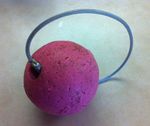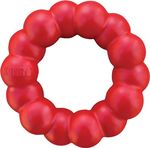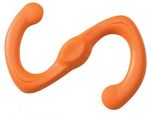Toy Policy - Guide Dogs for the Blind
←
→
Page content transcription
If your browser does not render page correctly, please read the page content below
Toy Policy Toys are an important part of a puppy's development. Appropriate toys provide mental stimulation, an outlet for normal chewing drive, and provide a positive alternative to destructive chewing of personal property. A stimulating variety of toys keeps the puppy occupied. Puppies, like children, become bored with the same toys; it is highly recommended that types of toys be rotated frequently. Puppies should have a number of toys to choose from at all times; not only does this help keep the pup engaged but also reduces the chance of him ultimately becoming protective of his toys. Not all toys currently on the market are safe for the ages, sizes or breeds of puppies in our program. In addition, some toys and activities are counterproductive to developing a working guide. Remember, a guide must willingly work past common distractions such as balls, Frisbees or other toys encountered in everyday life. Toys can be effective tools in reducing attention-seeking behaviors such as 'keep away'. Puppies pick up unacceptable items and 'parade' them to get raisers' attention; praising and admiring the pup that parades his toys will make him less likely to steal household items. A pup that brings his toys to the raiser is to be encouraged, but under no circumstances should raisers throw toys for a pup or participate in retrieve games. Even the best toys experience normal wear and tear. Toys should be routinely checked for any damage, splintering or wear. Special attention should be paid to ensure the toy has not become worn to the point of becoming too small, thus posing a choking or ingesting hazard. Some dogs are voracious chewers and will destroy even the strongest, safest toys. Observe your puppy and use toys with caution with strong chewers. Please review the document Food Containing Toys: Stuffed Kong and Wobbler for guidelines on use and seeking permission to offer toys containing food. The toys in the list below have been carefully researched by GDB staff; these are the only toys that may be accessed by a program puppy. Be sure to stay with the brand names listed below as not all toys are of good quality material. Guide Dogs for the Blind Puppy Raising Manual | Version: August, 2020
GDB APPROVED TOYS
General Use Toys:
These toys can be left readily available for a pup to play with at will.
Kong brand: black original and Ultra Kong 6”.
Black Kongs are stronger than red ones. Only
the original Kong shape is approved; no balls,
Frisbees, chews etc.
Goughnuts
ring or stick;
green or
yellow (same
strength) for
most puppies
and black for
extremely
hard chewers
Galileo 5” or 6” by Nylabone,
also now packaged as ‘Dino
Bones’.
Nylabone products: Nyla
Wishbone, Nyla Ring,
Durachew Textured Ring, Nyla
Knot, Dinosaur, DuraChew
Hollow Stick, any Nylabone
(original hard material) that is
appropriately robust enough for
the size of puppy. The products
will be packaged as “BIG
Chews”, Dura Chews and
Dental Chews.
Note: no chew products
with any sort of
rubber/plastic/fabric are
approved.
Sterilized Bones: at least 4" long
No smoked or meaty bones.
Guide Dogs for the Blind Puppy Raising Manual | Version: August, 2020With Supervision Only:
Tug toys should be put up, away from the puppy, after the game to maintain a
balanced relationship. All of these toys can be interactive. Puppies must be closely
observed the whole time they are playing with all of these toys, as they can be easily
shredded and consumed:
Goughnuts Tug Toy
Rubber ring, rubber Figure 8 and JW rings tug
toys
Olly Bone II (10" size recommended); made
by Ollydog
Tuffy's Ultimate Tug-O-War
Bumi by West Paw Design (large size)
Guide Dogs for the Blind Puppy Raising Manual | Version: August, 2020Jollyball (no handle) with a rope through
middle, sold as Romp-N-Roll
Toss 'n' Floss is a similar large ball with rope
through it, also approved
Raisers need to trim the frayed ends of the rope
on the Jolly Ball to reduce the temptation for
puppies to shred them. A very safe alternative is to
remove the rope and replace it with the same
plastic-covered cable our tie-downs are made of. A
visit to the hardware store will supply cable and
clamps to make a super durable “handle” for the
pups to carry (see photo for example). Of course,
this is a toy that is for supervised play only and
should not be left with a puppy unattended.
Gallon sized or larger plastic bottles:
Thoroughly rinsed, lids, labels and tops
removed (sturdy orange juice or detergent
bottles only) no water bottles or milk container
jugs
Restricted, for Younger Pups Only:
Discontinue use with puppies over 4 months of age
FlexiChew products by Nylabone (not with any
fabric/rubber/plastic as part of the toy)
Nylabone products labeled “Puppy Chews” are
not approved due to the variation in durability;
these include the keys, pacifier and rings.
Dental Chew products by Nylabone (not with
any fabric/rubber/plastic as part of the toy)
Nylabone products labeled “Puppy Chews” are
not approved due to the variation in durability;
these include the keys, pacifier and rings.
Guide Dogs for the Blind Puppy Raising Manual | Version: August, 2020Hercules bones (similar to above)
KONG Ring (Medium/Large)
KONG Wubba (regular or fleece “Snugga”)
*with supervision only; do not leave
unattended
Gnawt-a-Cone™ from Ruffwear
Guide Dogs for the Blind Puppy Raising Manual | Version: August, 2020Tux Toy from West Paw Design
Flat, unstuffed fleece toys; no squeakers
*with supervision only; do not leave
unattended
GoughNuts Lite products
Original GoughNuts Lite is approved for
puppies up to 12 weeks of age only
MaXX GoughNut Lite is approved for puppies
up to 16 weeks of age
Note: The .75 GoughNuts Lite is not approved for
puppies in raiser homes due to the small size
Unacceptable Toys:
• Edible toys: cornstarch bones, rawhide chews/toys, pigs ears, cow hooves, edible
Nylabones
• Balls
• Frisbees
• Rope toys
• Retrieving toys
• Raw bones
• Sticks
• Personal items: socks, children's toys, etc.
• Anything not on the approved list
Guide Dogs for the Blind Puppy Raising Manual | Version: August, 2020You can also read



























































